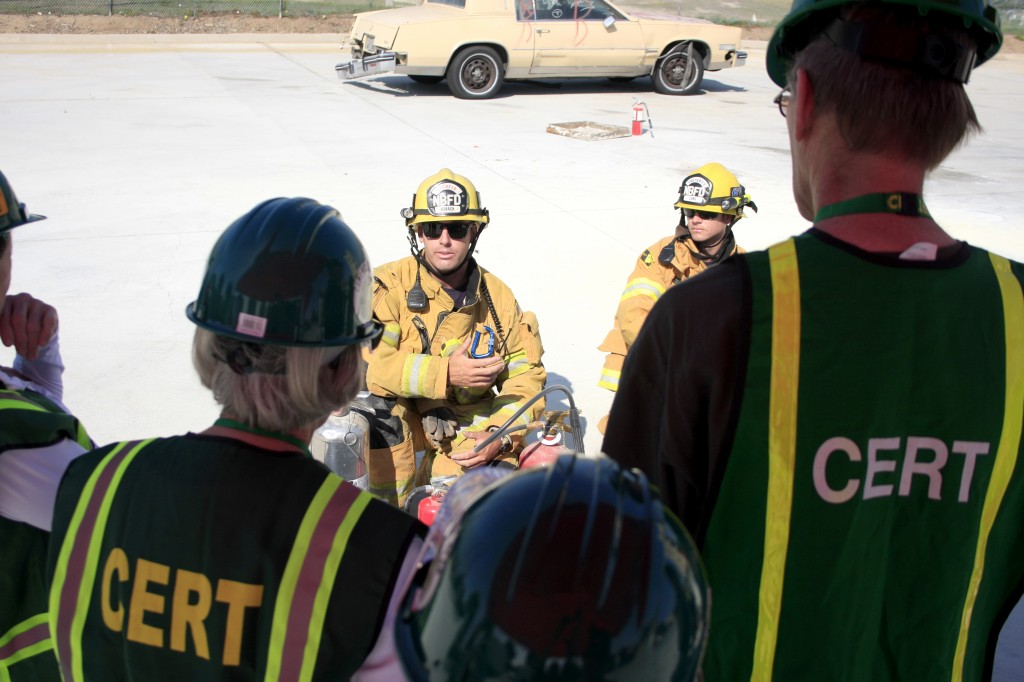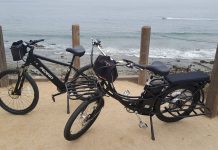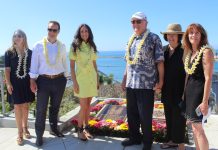
The first set of fall 2014 classes for the Community Emergency Response Team started last week
Groups of Newport Beach locals and other Orange County residents gathered at the Santa Ana Heights fire station on Tuesday, Thursday and Saturday to learn how to become better prepared for themselves, their family and their neighborhood in the event of an emergency.
I was among the volunteers participating in the all-day Saturday session.
After covering various CERT events and other stories, I thought it was about time I joined the team.
Supplies for the class include a nearly 200-page custom Newport Beach handbook, an even thicker manual that covers a broad spectrum of topics from the national CERT organization, a disaster supply kit checklist, and, upon completion, helmet, vest and nametag.
My group of 17 CERT volunteers ranged from teenagers to retired seniors, men and women, from various neighborhoods throughout the city and a few out-of-towners, and from all walks of life with different levels of experience.
The group was eager to learn and several attendees asked thoughtful questions and discussed the topics during breaks and lunch.
CERT program coordinator and Newport Beach Fire Department life safety specialist Matt Brisbois led the class.
“Thank you for volunteering to take care of yourself,” Brisbois said. “That’s what this program is all about.”
The Community Emergency Response Team is a FEMA training program which cover the skills and information necessary during a disaster.
“This is about educating you about what could happen,” Brisbois said. “It’s about getting you ready and having realistic expectations of what you need to do following any type of unexpected disaster.”
In the event of a disaster, emergency resources are quickly depleted and cannot provide immediate aid to everyone. People will have to rely on themselves and each other.
Help won’t be coming for “quite some time,” Brisbois noted.
On Saturday, class participants learned about the purpose of CERT, disaster kits, disaster psychology, the hazards that face Newport Beach and their potential effect on the city, CPR and more.
Disaster kits are one of first steps someone can take for emergency preparedness.
The basics include food and water, flashlights, first aid kit, tools, radio, medication, supplies for children and pets, cash and personal documents. Things like glow sticks, goggles, paper and pencil/pen, and a can opener are items many may not consider, but could be very helpful.
While I have one in my own home, I learned Saturday that it was seriously under-supplied.
Lifeguard Captain Mike Halphide taught the class about disaster psychology. As an emergency worker, you are dealing with people on the worst day of their lives, Halphide said.
Highlights of his talk include changing your response to an event, limiting the effects of vicarious trauma, don’t over-identify with survivors, taking action to reduce stress, meeting your own emotional, psychological and spiritual needs, physiological symptoms, teamwork, pacing yourself and more.
He also spoke about survivors having “a normal reaction to an abnormal event.”
Abnormal events could mean a number of things for Newport Beach.
According to the University of Southern California hazard analysis, the event with the highest Chance of Occurrence in Newport Beach is an earthquake. It rated at the very top on a scale of one to 10. The effect of an earthquake in Newport Beach was rated nine.
The city sits directly on top of the Newport-Inglewood Fault. This active fault runs under Hoag Presbyterian Memorial Hospital and the Newport Pier and then runs about 125 miles offshore.
“The Newport-Inglewood is a very big fault and a very active fault,” Brisbois said. “A big one, with the epicenter in Newport, would really be catastrophic for our city.”
Experts figure a fault like the Newport-Inglewood should have a big earthquake, 6.0 or above, every 100-150 years, he explained. With the last major event being the 1933 Long Beach earthquake, he added, that window is getting smaller.
Other hazards identified by the USC study, listed according to their COO rank, include: Hazardous materials event, fire or explosion, flood/storm, oil spill and/or pipeline breakage, tornado or water spout, aircraft accident, terrorism, energy shortage, war, tsunami, riot/civil disturbance, and nuclear accident.
Twin sisters and retired nurses Marilyn Broughton and Evalie DuMars closed the class on Saturday by teaching volunteers CPR. Participants took turns with chest compressions on the dummies as Halphide gave a real life scenario. Broughton and DuMars also showed the group how to use an automated external defibrillator. The two also teach CPR certification classes and wildlife first aid for CERT graduates.
Saturday’s class also went over the history and philosophy of CERT, how the city is split up into neighborhoods, significant disasters in history, earthquake, fire and flooding scenarios, social media, partners in preparedness, and much more.
CERT volunteer Peter Putnam also spoke to the class about radio communication.
Next for CERT students: Fire suppression, light search and rescue, disaster medical operations and more. Graduation, or the bi-annual “Drill the Skills” event, will be held Oct. 16 at the Santa Ana Heights fire station.




